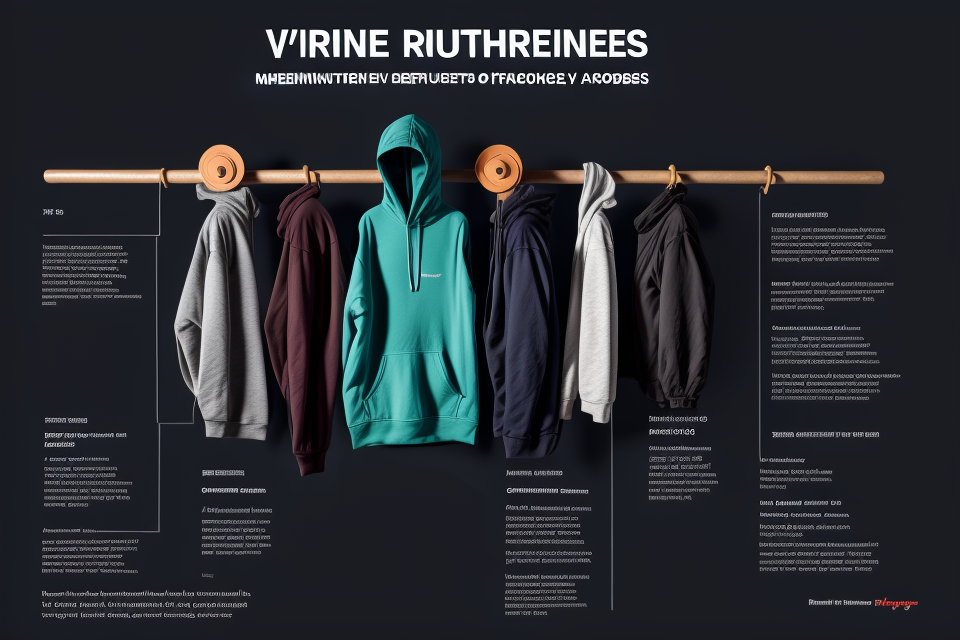
Hoodies have been a wardrobe staple for decades, providing warmth and comfort to millions of people around the world. But have you ever wondered where hoodies came from and what materials were used to make them? In this article, we will explore the origins of hoodie materials and where hoodies were first made. From the earliest days of hoodie production to the modern age, we will delve into the history of this iconic garment and uncover the stories behind the materials that have made it a fashion classic. So, buckle up and get ready to discover the fascinating world of hoodie materials!
The origins of hoodie materials can be traced back to various cultures and regions around the world. Hoodies were initially made from simple materials such as wool, cotton, and fleece. The garment was initially worn by laborers and athletes who needed a practical and comfortable garment to keep them warm during outdoor activities. Over time, hoodies have become a fashion statement and are now made from a wide range of materials, including synthetic fabrics and blends of natural and synthetic fibers. The modern hoodie is often associated with urban streetwear and is worn by people of all ages and backgrounds.
The History of Hoodies: From Monks to Modern Streetwear
The Roots of Hoodies: Ancient Religious Garments
The history of hoodies can be traced back to ancient religious garments worn by monks and priests in Christian monasteries and Islamic culture. These hooded garments served a practical purpose of providing warmth and protection from the elements, as well as a symbolic purpose of representing humility and devotion.
Hooded Cloaks in Christian Monasteries
In Christian monasteries, hooded cloaks were worn by monks as a symbol of humility and devotion. These cloaks were often made of wool or other warm materials and were designed to be worn over the habits of the monks. The hoods provided protection from the cold and rain, as well as a way to maintain a sense of modesty and humility.
The hooded cloaks worn by monks were not only functional but also served as a symbol of the monk’s spiritual journey. The hood represented the monk’s willingness to surrender his worldly possessions and submit himself to a life of prayer and contemplation. The hood also represented the monk’s willingness to listen to the teachings of the church and follow the example of Jesus Christ.
Hooded Garments in Islamic Culture
In Islamic culture, hooded garments were also worn by religious figures as a symbol of humility and devotion. The traditional Muslim prayer cap, known as the kufi, is a simple hooded garment that is worn by Muslims during prayer. The kufi is typically made of a lightweight fabric such as cotton or silk and is designed to be worn over the head and neck.
The kufi serves several purposes. It provides a level of modesty and humility by covering the head and neck, which are considered sacred areas in Islamic tradition. The kufi also helps to focus the mind during prayer by providing a physical reminder of the devotee’s connection to God.
In addition to the kufi, Islamic culture also includes the traditional robe-like garment known as the abaya. The abaya is a long, hooded cloak that is worn over the clothing and is often made of heavy fabrics such as wool or cotton. The hood of the abaya serves to protect the wearer from the elements, as well as to maintain a sense of modesty and humility.
Overall, the roots of hoodies can be traced back to ancient religious garments worn by monks and priests in Christian monasteries and Islamic culture. These hooded garments served a practical purpose of providing warmth and protection from the elements, as well as a symbolic purpose of representing humility and devotion.
The Evolution of Hoodies: Transitioning to Modern Streetwear
Hip Hop and Sportswear Brands
The evolution of hoodies from monastic garments to modern streetwear can be traced back to the 1970s, when hip hop culture emerged and embraced sportswear brands. The hoodie, with its comfortable fit and convenient hood, became a staple of this new cultural movement. Brands like Champion and Adidas began to incorporate hoodies into their collections, and the hoodie’s popularity soared.
The Rise of Streetwear Culture
The 1990s saw the rise of streetwear culture, which embraced the hoodie as a symbol of urban style. Brands like Nike, Stussy, and Supreme began to create hoodies with bold graphics and colors, making them a fashion statement. The hoodie was no longer just a functional garment, but a status symbol and a way to express one’s identity.
As streetwear continued to grow in popularity, the hoodie became a mainstay of modern fashion. High-end designers like Gucci and Balenciaga began to incorporate hoodies into their collections, elevating the garment to new levels of style and luxury. Today, the hoodie is a versatile and iconic piece of clothing, beloved by people of all ages and backgrounds.
Understanding the Materials Used in Hoodie Production
Common Fabrics Used for Hoodies
Cotton
Cotton has been a staple material for hoodie production since the early days of the garment. Its soft, breathable, and durable properties make it an ideal choice for creating comfortable and long-lasting hoodies. The natural fibers of cotton also allow for excellent moisture-wicking capabilities, which is crucial for maintaining comfort during wear. Additionally, cotton hoodies are generally easier to care for, as they can be washed and dried without the risk of shrinkage or damage.
Synthetic Fabrics
Synthetic fabrics, such as polyester and nylon, have become increasingly popular in hoodie production due to their unique properties. These materials are lightweight, quick-drying, and resistant to wrinkles, making them convenient for travel and everyday wear. Synthetic fabrics also tend to be more affordable than natural materials like cotton, which has contributed to their growing popularity among consumers. However, some drawbacks of synthetic fabrics include their tendency to trap heat and their potential to release microplastics during washing.
Blends and Combinations
Blends and combinations of different fabrics are commonly used in hoodie production to take advantage of the unique properties of each material. For example, cotton-polyester blends offer the softness and comfort of cotton with the durability and moisture-wicking capabilities of polyester. These blends are often used to create hoodies that are both comfortable and long-lasting. Additionally, some hoodies are made with a combination of natural and synthetic materials, such as cotton and nylon, to create a garment that offers the best of both worlds in terms of comfort, durability, and affordability.
Factors Influencing Hoodie Material Selection
Durability and Weather Resistance
The materials used in hoodie production must be durable enough to withstand regular wear and tear. The fabric must also be weather-resistant, meaning it can protect the wearer from harsh weather conditions. This is particularly important for outdoor activities or sports, where hoodies are often worn as part of a uniform or for practicality.
Comfort and Breathability
Comfort and breathability are crucial factors in hoodie material selection. The fabric must be soft to the touch, and the fit must be comfortable, allowing for a full range of motion. Breathability is also essential, as hoodies are often worn during activities that cause excessive sweating. Materials that wick moisture away from the body are preferred, as they help to keep the wearer dry and comfortable.
Style and Aesthetics
Style and aesthetics play a significant role in hoodie material selection. The fabric must not only perform its intended function but also look good. Different materials have different textures, colors, and patterns, and these factors influence the overall style of the hoodie. Hoodie materials may be plain or patterned, with a range of colors and textures available to suit different tastes and styles. The choice of material can also affect the overall look and feel of the hoodie, with some materials giving a more casual, sporty look, while others may appear more formal or dressy.
The Global Hoodie Manufacturing Landscape
Major Hoodie Producing Countries
China
China has long been a major player in the global textile industry, and hoodies are no exception. With a vast network of manufacturers and suppliers, China produces a significant portion of the world’s hoodies. The country’s textile industry is supported by a well-developed infrastructure, including efficient transportation systems and a large pool of skilled labor. As a result, China is able to produce hoodies at a relatively low cost, making them an attractive option for many clothing brands and retailers.
India
India is another significant producer of hoodies, with a textile industry that dates back thousands of years. The country has a rich history of cotton production, and its skilled weavers and artisans are known for their expertise in producing high-quality fabrics. Many Indian manufacturers specialize in producing hoodies made from organic cotton or other sustainable materials, making them an appealing choice for consumers who are environmentally conscious.
Bangladesh
Bangladesh has emerged as a major player in the global textile industry in recent years. The country has a large and growing population of young, skilled workers, and its government has implemented policies to support the growth of the textile sector. Many international brands and retailers have turned to Bangladesh as a source for their hoodies, due to the country’s low labor costs and favorable business environment.
Other Smaller Producers
In addition to these major producers, there are many smaller countries around the world that produce hoodies. These include countries in South America, Africa, and Southeast Asia, where the textile industry is a significant source of employment and income. While these countries may not produce hoodies on the same scale as China, India, or Bangladesh, they play an important role in the global hoodie supply chain.
Challenges and Controversies in Hoodie Manufacturing
Labor Rights and Working Conditions
The hoodie manufacturing industry has faced numerous challenges and controversies regarding labor rights and working conditions. Many companies have been accused of exploiting workers by paying them low wages, providing poor working conditions, and not providing them with adequate benefits. In some cases, workers have been forced to work long hours in dangerous environments, and their rights have been violated.
One of the most significant challenges in hoodie manufacturing is the lack of transparency in the supply chain. Many companies outsource their production to third-party manufacturers, making it difficult to trace the origin of the materials used in the hoodies. This lack of transparency makes it challenging to ensure that workers are being paid fairly and that their rights are being protected.
Environmental Impact of Hoodie Production
The production of hoodies also has a significant environmental impact. The materials used to make hoodies, such as cotton and polyester, require large amounts of water and energy to produce. Additionally, the chemicals used in the manufacturing process can have a detrimental effect on the environment. The waste generated by the manufacturing process also poses a significant challenge, as it can contribute to pollution and landfill problems.
Ethical and Sustainability Concerns
Hoodie manufacturing also raises ethical and sustainability concerns. Many companies have been criticized for their unsustainable practices, such as using harmful chemicals in the manufacturing process or sourcing materials from unsustainable sources. The fashion industry as a whole has been criticized for its contribution to waste and pollution, and hoodie manufacturing is no exception.
To address these challenges and controversies, many companies have implemented sustainable and ethical practices in their manufacturing processes. Some companies have switched to using organic cotton or recycled materials, while others have implemented fair labor practices and provided their workers with better working conditions. However, there is still much work to be done to ensure that hoodie manufacturing is sustainable and ethical.
The Future of Hoodie Materials and Manufacturing
Emerging Trends in Hoodie Materials
As the world becomes more conscious of sustainability and the impact of fast fashion on the environment, hoodie manufacturers are exploring new and innovative materials to create their products. Here are some of the emerging trends in hoodie materials:
Sustainable and Eco-Friendly Fabrics
One of the most significant trends in hoodie materials is the use of sustainable and eco-friendly fabrics. These fabrics are made from natural fibers such as organic cotton, bamboo, and hemp, which are renewable resources that require less water and energy to produce than traditional cotton.
Manufacturers are also exploring recycled materials, such as recycled polyester and nylon, which are made from plastic bottles and other waste products. These materials not only reduce waste but also require less energy and water to produce than virgin materials.
High-Tech and Performance Materials
Another trend in hoodie materials is the use of high-tech and performance fabrics. These fabrics are designed to provide superior comfort, warmth, and breathability, making them ideal for outdoor activities such as hiking, skiing, and cycling.
Some of the high-tech fabrics used in hoodies include moisture-wicking materials, which draw sweat away from the body and keep the wearer dry and comfortable. Other materials, such as wind-resistant and waterproof fabrics, provide additional protection against the elements.
In addition, some manufacturers are experimenting with smart textiles, which use technology to provide additional benefits such as UV protection, temperature regulation, and even charging for electronic devices.
Overall, the future of hoodie materials looks promising, with manufacturers exploring new and innovative fabrics that are not only comfortable and stylish but also sustainable and eco-friendly. As consumers become more conscious of their impact on the environment, these trends are likely to continue and shape the future of the hoodie industry.
The Impact of Digitalization and Technology on Hoodie Production
Digitalization and technology have had a profound impact on the production of hoodies, revolutionizing the way they are made and offering new possibilities for customization and innovation. Here are some of the key ways in which technology is shaping the future of hoodie manufacturing:
3D Printing and Customization
One of the most exciting developments in hoodie production is the use of 3D printing technology. This allows for the creation of hoodies that are tailored to the individual measurements and preferences of each customer, ensuring a perfect fit every time. With 3D printing, designers can also experiment with new shapes and styles, creating hoodies that are both functional and fashionable.
Advanced Robotics and Automation
Another way in which technology is transforming hoodie production is through the use of advanced robotics and automation. This allows for greater efficiency and accuracy in the manufacturing process, reducing the risk of errors and improving the overall quality of the finished product. For example, robots can be programmed to perform tasks such as cutting fabric, sewing, and inspection, ensuring that every hoodie meets the highest standards of quality and consistency.
Overall, the impact of digitalization and technology on hoodie production is significant, offering new possibilities for customization, innovation, and efficiency. As these technologies continue to evolve, it is likely that we will see even more exciting developments in the world of hoodie manufacturing.
The Growing Importance of Ethical and Sustainable Manufacturing Practices
As the fashion industry continues to evolve, so too does the importance of ethical and sustainable manufacturing practices in the production of hoodies and other clothing items. With growing consumer demand for transparency and responsibility, as well as government regulations and policy changes, brands are under increasing pressure to adopt more ethical and sustainable practices in their manufacturing processes.
One key aspect of ethical and sustainable manufacturing is the use of certifications and standards. These certifications, such as Organic Content Standard (OCS) and Fair Trade USA, help to ensure that materials used in the production of hoodies are organic, sustainably sourced, and produced under fair labor conditions. Brands that hold these certifications can demonstrate their commitment to ethical and sustainable practices, which can help to build trust with consumers and differentiate themselves from competitors.
In addition to certifications, consumer demand for transparency and responsibility is also driving the adoption of ethical and sustainable manufacturing practices. Consumers are increasingly interested in knowing where their clothing is produced, how it is made, and under what conditions. Brands that can provide this information and demonstrate their commitment to ethical and sustainable practices are more likely to build loyal customer bases and differentiate themselves from competitors.
Government regulations and policy changes are also playing a role in the adoption of ethical and sustainable manufacturing practices in the production of hoodies and other clothing items. In many countries, there are laws and regulations in place that require brands to disclose information about their supply chains and manufacturing processes. These regulations can help to ensure that brands are adhering to ethical and sustainable practices, and can also help to protect workers’ rights and the environment.
Overall, the growing importance of ethical and sustainable manufacturing practices in the production of hoodies and other clothing items is a trend that is likely to continue in the future. As consumers become more aware of the impact of their purchasing decisions on the environment and society, brands that can demonstrate their commitment to ethical and sustainable practices will be better positioned to succeed in the marketplace.
FAQs
1. What is a hoodie?
A hoodie is a type of sweatshirt that has a hood attached to the back of the neckline. The hood is often worn over the head to provide additional warmth and protection from the elements. Hoodies are typically made from a variety of materials, including cotton, fleece, and synthetic fabrics.
2. When were hoodies first invented?
The origins of the hoodie are somewhat unclear, but it is believed that the first hoodies were created in the 1930s as a type of athletic wear. They gained popularity in the 1970s as a casual, everyday garment and have since become a staple of many people’s wardrobes.
3. What materials are used to make hoodies?
Hoodies can be made from a variety of materials, including cotton, fleece, and synthetic fabrics such as polyester and nylon. The choice of material depends on factors such as the intended use of the hoodie, the climate in which it will be worn, and personal preferences.
4. Where were hoodies first made?
The exact origin of hoodies is difficult to pinpoint, but they are believed to have been first produced in the United States. They have since become popular around the world and are now made in many different countries.
5. How has the design of hoodies changed over time?
The design of hoodies has evolved over time, with new styles and features being added to meet changing fashion trends and consumer needs. For example, some hoodies now have zippers or drawstrings to adjust the fit, while others may have additional pockets for storage. Additionally, hoodies are now available in a wide range of colors and patterns to suit different tastes and styles.


